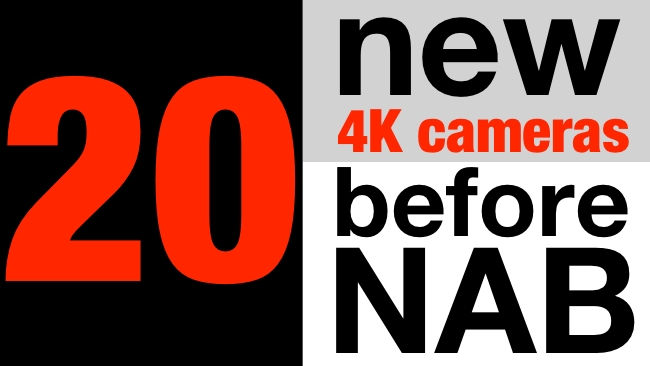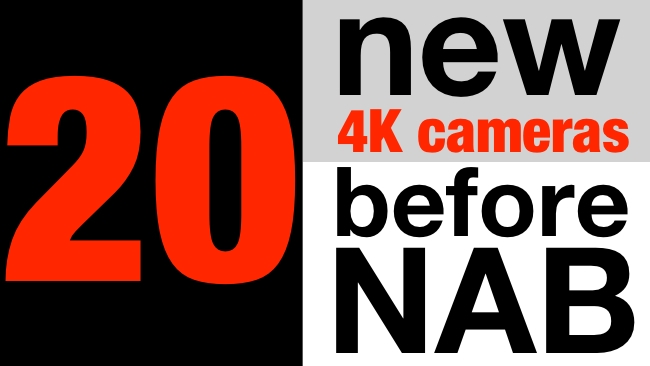
 20 new 4K cameras to arrive before NAB 2014
20 new 4K cameras to arrive before NAB 2014
Expect up to 20 new 4K cameras to hit the market before NAB, says Atomos Chief Executive
Speaking to RedShark, Atomos CEO and Co-Founder Jeromy Young said "we have reason to believe that up to 20 new 4K cameras will be announced before next year's NAB".
Atomos, based in Melbourne, Australia designs and manufactures low-cost external recorders that can also be used as field monitors, as well as a range of portable, battery powered signal format converters.
Fluent in Japanese, Young liaises with and maintains a close relationship with camera makers. And although he was unable to give any specific details because of strict non-disclosure agreements, he did comment that "90% of filmmakers are still recording in HD, and will continue to do so for at least two years."
Plans for 4K
The Atomos CEO told us that they do have well-advanced plans for a 4K device which "will be a world-beater" but that they are waiting for a greater uptake of 4K generally before they complete and release it.
"We think its better to wait and produce a device that is perfect for a more mature market than to release something now, while there are so many things still to be settled in the 4K arena"
Atomos recently introduced its Samurai Blade combined recorder/monitor that includes waveform monitoring and what Atomos are touting as a SuperAtom 5" 1280 x 720 325ppi IPS touchscreen. We'll be carrying a full review of this in the next few weeks.
External Recording
When the original Atomos Ninja recorder first shipped in 2011, there were no video-capable DSLRs that offered a "clean" HDMI output, severely reducing the potential market for external recorders. Young was instrumental in persuading the camera manufacturers to clean up their outputs and make an external recording workflow viable. This year, the popular Canon EOS 5D mk III received a firmware update to allow external recording.
External recorders work by taking the uncompressed video sent through of the HDMI or SDI output on a camera and recording it to on-board storage either compressed (usually Apple ProRes or Avid DNxHD) or uncompressed. Uncompressed recording offers no degradation in the signal and the Apple and Avid codecs are "visually lossless" at their higher available bitrates, which means that material that is stored on an external recorder is higher quality than the typically more heavily compressed material that is stored on the camera itself.
The other advantage of using these "edit-friendly" formats is that they can be imported directly onto a timeline without any transcoding. Since each frame is compressed individually, without reference to any others, the material is in an ideal form for editing, since the NLE software and the workstation hardware does not have to waste valuable cycles re-creating specific frames from the surrounding material. In practise this normally means that more streams (layers) of video can be edited in real time, and the whole editing process is more responsive.
The Challenge
The Avid and Apple codecs are intrinsically 10 bit, but, even though the HDMI output of most cameras (and the SDI output on some) is only 8 bit, by working within a 10 bit space, there is a potential improvement in quality for the final edit because the results of any processing (colour grading, level adjustment etc) can be stored with a higher precision.
The challenge now for all external recorder manufacturers is to create solutions for dealing with 4K. Some already have, with various approaches, some of them tied in closely to specific camera models.
There are several reasons why producing a viable external recorder for 4K is more difficult. The first and most obvious is that the data rates are at least four times higher. There's no gradual increment in moving from HD to 4K, everything, literally, is four times as fast.
To put this in perspective, when HD external recording stated, working with ProRes and DNxHD resulted in data rates that were relatively easy to cope with. Atomos was even able to record at these rates onto spinning hard disks - giving very long record times. Some manufacturers, such as Blackmagic, offered uncompressed recording but to SSD only. Uncompressed HD is typically six times the data rate of the production codecs.
But it's not just a matter of data rates. With 4 times the resolution, any processing that takes place will need four times the resources. And fitting all of this into low-cost processors and FPGAs is not a trivial task.
The Elephant in the room
So recording 4K with ProRes or DNxHD is going to bring data rates into the same sort of range as recording HD uncompressed: completely do-able.
But the elephant in the room is higher frame-rates. If you more than double the framerate from 24 fps to 60, then the data rate more than doubles as well. What's more, even the so-called "6G" SDI standard is unable to handle frame-rates at 4K more than 30 fps.
On the other hand, 50p and 60p at HD resolutions are not even broadcast standards yet, so higher framerates at 4K are likely to be restricted to special effects, and may not be available on mainstream external recorders.
The other complication that is not directly a result of 4K but which will be more and more associated with it is the workflow necessary to deal with raw video. There is no standard way to get raw video from a camera to an external recorder.
It's going to be an interesting time for the external recorder manufacturers, and we certainly think that Atomos is taking a sensible approach in waiting for the predicted rush in 4K cameras to happen before committing to a final design.
Get ready for the next generation of cameras with this article: Preparing to shoot raw
Tags: Technology


Comments